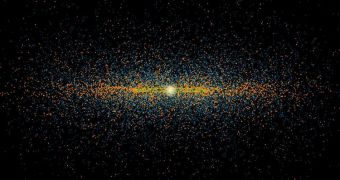Using data from an American telescope, scientists have recently created the most complete survey of potentially hazardous asteroids in our solar system. The dataset includes information about the space rocks' total number, their origins, and the nature of the dangers they could pose to our planet.
The observations included in this research were collected using the NASA Wide-field Infrared Survey Explorer (WISE) satellite. It launched from Space Launch Complex 2W at the Vandenberg Air Force Station on December 14, 2009, aboard a Delta II delivery system.
WISE was put into hibernation on February 1, 2011, after completing its initial mission and an extended science phase, called NEOWISE. Preliminary data from the spacecraft were released on April 14, 2011, while the full data release occurred on March 14, 2012.
Given that its infrared detectors were around 1,000 times more sensitive than those of any similar telescope, WISE was able to image objects that other observatories simply could not see. It discovered the first-ever Earth Trojan asteroid, as well as a previously unknown type of star called an Y dwarf.
But its capabilities were also used to detect potential threats to Earth, primarily during the 4-month mission extension known as Near-Earth Object WISE (NEOWISE). The purpose of this investigation was to create a map of asteroids near our planet that could become dangerous in the future.
NASA classified potentially hazardous asteroids (PHA) as a subgroup of near-Earth asteroids (NEO). Of the latter category, many will never pose a threat to Earth. In order for a space rock to be cataloged as a PHA, it needs to come within 5 million miles (some 8 million kilometers) from Earth's surface.
Additionally, they need to be sufficiently large to undergo atmospheric reentry and not explode. Their threat level assessment is also based on the scale of the devastation they would cause if they somehow managed to impact the planet.
“The NEOWISE analysis shows us we've made a good start at finding those objects that truly represent an impact hazard to Earth,” NASA Headquarters Near-Earth Object Observation Program program executive, Lindley Johnson, explains.
“But we've many more to find, and it will take a concerted effort during the next couple of decades to find all of them that could do serious damage or be a mission destination in the future,” the expert adds.
“NASA's NEOWISE project, which wasn't originally planned as part of WISE, has turned out to be a huge bonus. Everything we can learn about these objects helps us understand their origins and fate. Our team was surprised to find the overabundance of low-inclination PHA,” adds Amy Mainzer.
“Because they will tend to make more close approaches to Earth, these targets can provide the best opportunities for the next generation of human and robotic exploration,” concludes the NASA Jet Propulsion Laboratory (JPL) expert, who was the principal investigator for the NEOWISE mission.

 14 DAY TRIAL //
14 DAY TRIAL //